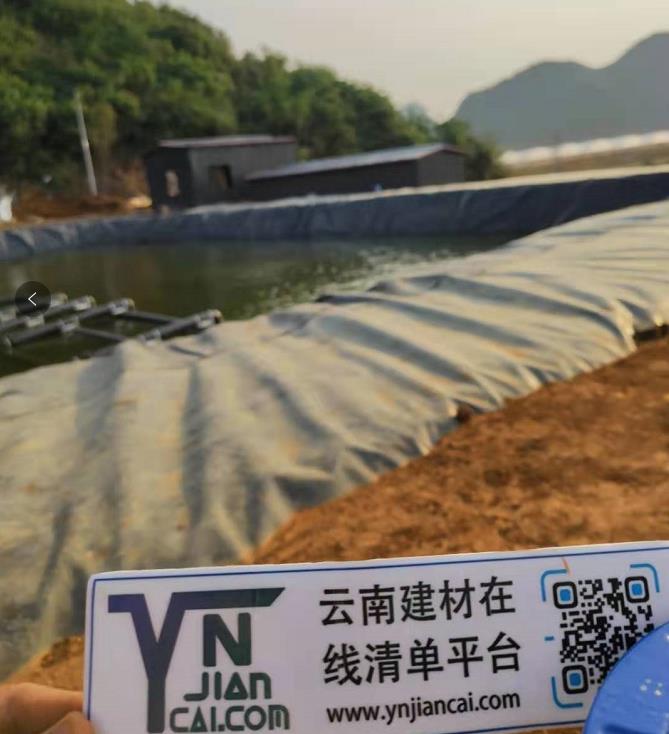
Geomembrane construction method 1.
Laying of HDPE geomembrane
1. Before laying HDPE geomembrane, the corresponding qualified acceptance certificate of civil engineering should be obtained.
2. Before cutting the HDPE membrane, its relevant dimensions should be accurately measured, and then cut according to the actual size. It is generally not suitable to cut according to the illustrated dimensions. Each piece should be numbered and recorded in detail on a special form.
3. When laying HDPE geomembrane, the welds should be minimized, and raw materials should be saved as much as possible while ensuring quality. It is also easy to ensure quality.
4. The overlap width of the joints between membranes is generally not less than 10cm, and the weld arrangement direction is usually parallel to the maximum slope, that is, arranged along the slope direction.
5. Usually, in corners and deformed areas, the length of the joints should be shortened as much as possible. Except for special requirements, no welds should be set within 1.5 meters from the top slope or stress concentration area on slopes with a slope greater than 1:6.
6. When laying HDPE geomembrane, artificial wrinkles should be avoided. When the temperature is low, it should be tightened and laid flat as much as possible.
7. After the HDPE geomembrane is laid, walking on the membrane surface and moving tools should be minimized. Any objects that may cause harm to the HDPE membrane should not be placed on the membrane or carried on the membrane to avoid accidental damage to the membrane.
Composite geomembrane construction plan 2
Welding of composite geomembrane
1. The welding process of the hot wedge welding machine is divided into: adjusting pressure, setting temperature, setting speed, welding seam overlap inspection, loading the membrane into the machine, starting the motor, and pressurizing welding.
2. There should be no oil or dust at the joints, and the overlapping section of the HDPE geomembrane should not be sandwiched with mud and sand and other debris. If there are debris, it must be cleaned before welding.
3. At the beginning of welding every day, a 0.9mm×0.3mm sample must be welded on site first, with an overlap width of not less than 10cm, and a tensile machine must be used to perform peeling and shearing tests on site. After the sample is qualified, the speed, pressure and temperature adjusted at that time can be used for correct welding. The date, time and ambient temperature must be marked on the sample. During the welding process, the hot wedge welder must pay attention to the operation of the welder at any time, and the speed and temperature must be fine-tuned according to the actual situation on site.
4. The welds must be neat and beautiful, and there must be no slip welding or jumping.
5. When the geomembrane is not long enough and needs to be spliced in the long direction, the transverse welds should be welded first, and then the longitudinal welds. The transverse welds should be T-shaped when they are more than 50cm apart, and no cross-shaped should be allowed.
6. Adjacent geomembrane welds should be overlapped as much as possible, and the nodes formed between the membrane blocks should be T-shaped, and the cross-shaped should be minimized. The intersection of the longitudinal welds should be strengthened with an extrusion welder.
7. Do not press out dead folds when welding the membrane. When laying HDPE geomembrane, reserve the expansion and contraction caused by temperature changes according to the local temperature change range and HDPE geomembrane performance requirements.
8. When the temperature of the welding machine indicated by the temperature control of the portable welding machine is lower than 200℃, use a clean cloth or cotton yarn to wipe it off before welding. If necessary, it should be re-polished. Do not wipe it with your hands.
9. When the joints are affected by condensation, moisture, mud and sand, etc., weld them after treatment.
10. Welding cannot be carried out during rainy periods or when there is moisture, dew, or heavy sand on the joints, except when protective measures are taken.
11. When the temperature is lower than 5℃, construction should not be carried out according to the specifications. If construction is necessary, the welding machine should be preheated before welding.
12. During the welding process of the extrusion welding machine, the slider of the gun head should be checked frequently. If the wear is serious, the slider should be replaced in time to avoid damaging the membrane surface.
13. When welding geomembrane, a generator with good voltage stabilization performance should be used for power supply. In special circumstances, when local electricity is used, a voltage stabilizer must be used.






 " />
" />